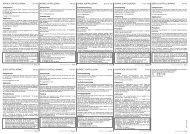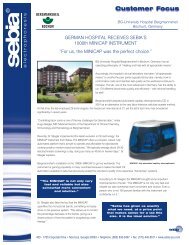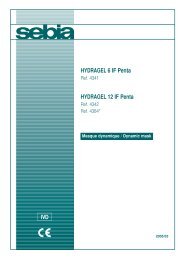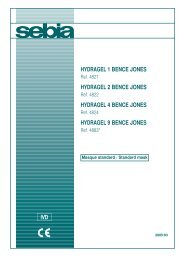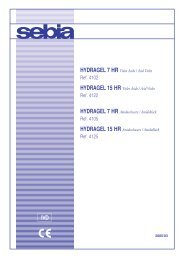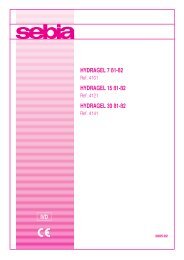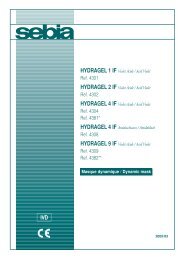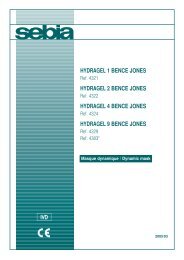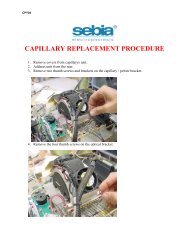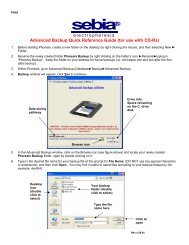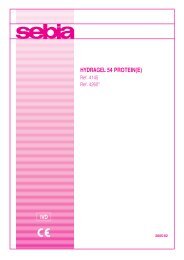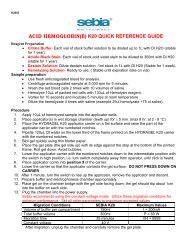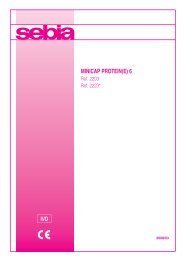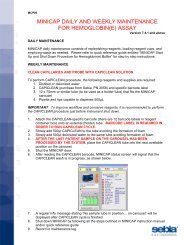CAPILLARYS HEMOGLOBIN(E)
CAPILLARYS HEMOGLOBIN(E) - Sebia Electrophoresis
CAPILLARYS HEMOGLOBIN(E) - Sebia Electrophoresis
- No tags were found...
Create successful ePaper yourself
Turn your PDF publications into a flip-book with our unique Google optimized e-Paper software.
<strong>CAPILLARYS</strong> <strong>HEMOGLOBIN</strong>(E) - 2010/10<br />
Quality control among a series of samples to analyze :<br />
The Hb AFSC Control should be used as a normal human blood. After reconstitution, use directly the Hb AFSC Control as a blood sample to analyze<br />
or as a migration control (with the sample rack No. 0, see the paragraph before). It will be automatically diluted with hemolyzing solution. It is<br />
recommended to include the Hb AFSC Control into each series of analysis.<br />
IMPORTANT: For optimal use of the Hb AFSC Control with the <strong>CAPILLARYS</strong> System, it is necessary to use one bar code label intended to identify<br />
the hemolyzing tube holding the microtube which contains the Hb AFSC Control (cut the cap of the microtube before using it).<br />
Storage, stability and signs of deterioration<br />
Before reconstitution, store the lyophilized Hb AFSC Control refrigerated (2 to 8 °C). It is stable until the expiration date indicated on the box or vial<br />
labels.<br />
Store the reconstituted Hb AFSC Control at 2 - 8 °C. Due to the risk of microbial contamination and denaturation, use it within one week.<br />
The reconstituted Control may also be frozen (in aliquots) and stored at - 20 °C for 6 months maximum.<br />
IMPORTANT: After storage at 2 - 8 °C or at - 20 °C, homogenize the reconstituted Hb AFSC Control before the analysis with the <strong>CAPILLARYS</strong> system.<br />
NOTE: For optimal use with the <strong>CAPILLARYS</strong> system, it is recommended to split the Control into aliquots in microtubes before freezing.<br />
Before use, store the thawed Hb AFSC Control at 2 - 8 °C and use it within the day, after homogeneization. Do not freeze and thaw the Control more<br />
than 10 times.<br />
No test method can provide an absolute assurance of the absence of HIV, hepatitis B and C or other infectious agents. Therefore, handle the Hb AFSC<br />
Control as a hazardous biological material.<br />
This control was found negative on assays approved by FDA or EU equivalent regulatory agency :<br />
- against hepatitis B surface antigen ;<br />
- for antibody to HCV ;<br />
- for antibody to HIV1 and HIV2.<br />
NOTE: During transportation, the lyophilized Hb AFSC Control can be kept without refrigeration (15 to 30 °C) for 15 days without any adverse effects<br />
on performance.<br />
EQUIPMENT AND ACCESSORIES REQUIRED<br />
1. <strong>CAPILLARYS</strong> System SEBIA, PN 1222.<br />
2. Sample racks supplied with <strong>CAPILLARYS</strong>.<br />
3. Container Kit supplied with <strong>CAPILLARYS</strong>: Rinse (to fill with distilled or deionized water), wash solution and waste container.<br />
SAMPLES FOR ANALYSIS<br />
Sample collection and storage<br />
Fresh umbilical cord blood samples from new-borns, anticoagulated with EDTA, are recommended for analysis. Avoid anticoagulants containing<br />
iodoacetate. Blood must be collected according to established procedures used in clinical laboratory testing.<br />
IMPORTANT: The volume of collected blood sample must not exceed the recommended volume of the collection tube. In the opposite case, if the<br />
volume of anticoagulant is insufficient for the collected blood sample, viscous aggregates in red blood cells may be observed. It is necessary to discard<br />
them before the analysis.<br />
Samples may be stored for up to 7 days between 2 and 8 °C.<br />
For longer storage, samples can be frozen at - 80 °C within 8 hours of collection after having washed the red blood cells according to the following<br />
procedure: Centrifuge anticoagulated blood at 5 000 rpm for 5 minutes; discard the plasma; wash the red blood cells (RBC) 2 times with 10 volumes<br />
of saline (centrifuge after each washing step); discard the excess of saline over the red blood cells pellet and vortex them before freezing.<br />
Frozen blood samples are stable for 3 months maximum at - 80 °C.<br />
IMPORTANT: For optimal storage of blood samples, store them at - 80 °C. Do not store at - 20 °C (see BIBLIOGRAPHY, J. Bardakdjian-Michau et al,<br />
2003).<br />
NOTE: Samples should not be stored at room temperature!<br />
Progressive hemoglobins (Hb) degradation may occur for samples stored between 2 to 8 °C.<br />
When the blood sample is stored for more than 7 days at 2 - 8 °C:<br />
• Degraded Hb F becomes more visible and appears as a shoulder on the cathodic side of the Hb A (C9 zone, see the table in paragraph<br />
"Interpretation") due to the sample degradation. The Hb A percentage is then overvalued.<br />
• When Hb A is present, a spread fraction corresponding to degraded Hb A ("aging fraction" of Hb A) appears more anodic (C11 zone, see the table<br />
in paragraph "Interpretation").<br />
• Due to the sample degradation, a weak fraction, corresponding to methemoglobin, may appear in the Hb E migration zone (C3 zone, see the table<br />
in paragraph "Interpretation").<br />
When stored for more than 10 days, viscous aggregates in red blood cells are observed; it is necessary to discard them before the analysis.<br />
Sample preparation<br />
• Let red blood cells precipitate for several hours at 2 - 8 °C or centrifuge the blood sample at 5 000 rpm for 5 minutes.<br />
• Discard carefully the maximum volume of plasma.<br />
• Vortex for 5 seconds.<br />
IMPORTANT: Do not use blood samples containing 3 mm maximum residual plasma over red blood cells; when more than 3 mm plasma is present<br />
in the tube, the analysis should be affected.<br />
- 60 -



